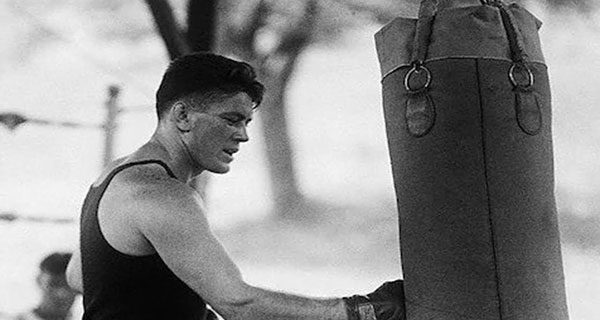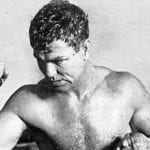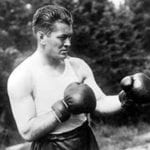 Last week’s column argued that Jack Dempsey’s July 1919 winning of the world heavyweight boxing championship prefigured the celebrity-obsessed Roaring ’20s. If so, Gene Tunney’s dispatching of Dempsey in 1926 and again 1927 can be viewed as a harbinger of the decade’s end.
Last week’s column argued that Jack Dempsey’s July 1919 winning of the world heavyweight boxing championship prefigured the celebrity-obsessed Roaring ’20s. If so, Gene Tunney’s dispatching of Dempsey in 1926 and again 1927 can be viewed as a harbinger of the decade’s end.
To be sure, the party didn’t come to a shuddering halt until the Wall Street crash of October 1929. But Tunney’s triumph put a serious dent in the cult of the professional sportsman as a larger-than-life figure.
Tunney was born in New York City to Irish immigrant parents from County Mayo. He was one of seven children and the family was decidedly working-class. So with no prospect of higher education and a need to contribute financially, he left school at 15 to take up a clerical position.
However, Tunney had serious aspirations for self-improvement. Reading incessantly, he developed a passion for words. He had brains and he intended to use them.
As a boxer, Tunney was cerebral. In contrast to Dempsey’s penchant for relentless aggression, Tunney approached a fight like a chess match, studying his opponent’s style and hatching an appropriate strategy. While he could take a punch, he preferred to avoid it where possible.
The first Dempsey-Tunney bout took place in Philadelphia on Sept. 23, 1926. Public interest was enormous and approximately 120,000 people bought tickets. It’d been three years since Dempsey’s last title defence and fans were hungry for excitement.
While Dempsey had been inactive and busying himself in Hollywood, Tunney had been perfecting his craft. He had 19 fights during that period, winning 18 and drawing the other. He was also two years younger.
From the get-go, Dempsey knew he was in trouble. Pursuing Tunney in typical style, he couldn’t catch him. Meanwhile, Tunney peppered him with punches. Dempsey’s performance struck journalist Paul Beston as being “like a dance partner obeying a lead.”
By the final bell, the unanimous decision was a foregone conclusion. Dempsey was no longer heavyweight champion of the world.
They met again a year later, in Chicago on Sept. 22, 1927. The official attendance of 104,943 paid almost $2.7 million while millions more listened on radio. And if the first fight produced a shock result, the second generated a controversy that still resonates.
It was the night of the infamous Long Count.
Repeating the previous pattern, Tunney more or less commanded proceedings for the first six rounds. Then Dempsey caught him with a seven-punch combination in the seventh and he went down.
However, Illinois rules – meticulously explained before the opening bell – required a fighter scoring a knockdown to go to the furthest neutral corner before the referee could start the count. Dempsey didn’t initially do that, wasting five seconds in the process. So when Tunney got up at the count of nine, he’d actually been down for 14 seconds.
Could Tunney have beaten the count without those extra five seconds? And if he had, would he have weathered the ensuing onslaught?
Tunney claimed that his mind was clear within a couple of seconds and that he simply opted to take the maximum respite. But all we know for sure is that he survived the round and subsequently resumed control, en route to winning another unanimous decision.
Tunney, though, wasn’t a popular champion.
In addition to his personal aloofness, his defensive fighting style was relatively dull. There was none of the explosive mayhem that accompanied a vintage Dempsey outing.
And he didn’t particularly care for sports writers, which was a feeling they reciprocated. They found him difficult to understand, even pretentious with his professed love for Shakespeare and his fondness for deploying his extensive vocabulary.
Mind you, Tunney’s enthusiasm for the literary world was real. For instance, a friendship with George Bernard Shaw lasted until Shaw’s death in 1950. Ernest Hemingway was another friendly acquaintance.
And unlike Dempsey, Tunney didn’t cultivate close ties with the boxing world in later life. Married to a steel heiress, he became a successful business executive. Boxing had served its purpose and he moved on.
Indeed, his son Jay recalls the family going to see Roy Rogers at Madison Square Garden in 1944 and being surprised when the spotlight picked out his father for special recognition. Prior to that, the youngster had no real sense that his father had been a famous fighter.
Troy Media columnist Pat Murphy casts a history buff’s eye at the goings-on in our world. Never cynical – well perhaps a little bit.
The views, opinions and positions expressed by columnists and contributors are the author’s alone. They do not inherently or expressly reflect the views, opinions and/or positions of our publication.



